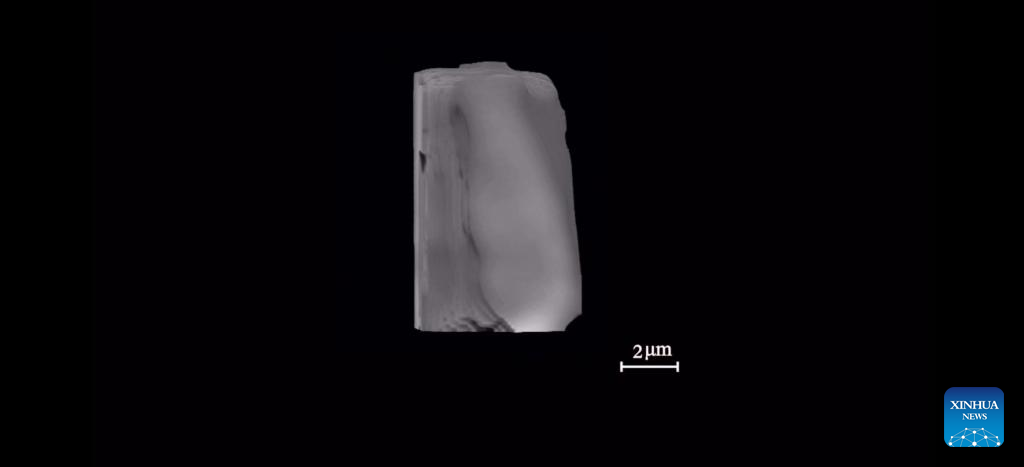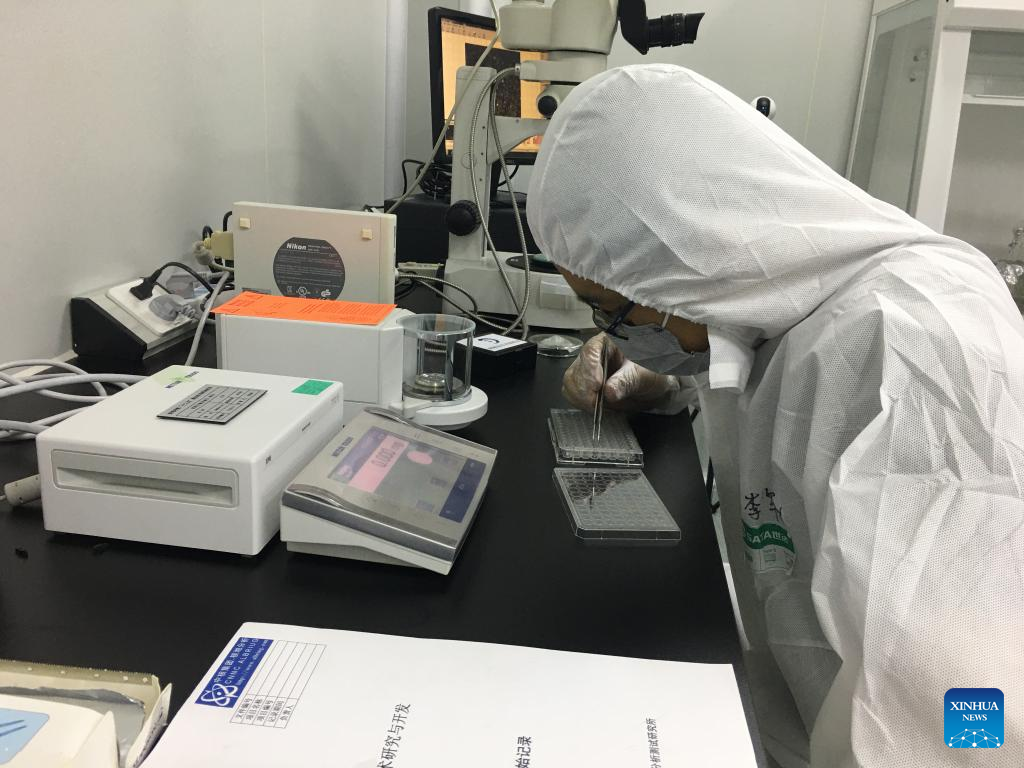
The photo taken in September 2022 shows the 3D morphology by a CT scan of the real particle of the new mineral Changesite-(Y).
Chinese scientists have discovered a new lunar mineral through research on the samples retrieved from the Moon by China's Chang'e-5 mission, the China National Space Administration (CNSA) and the China Atomic Energy Authority (CAEA) jointly announced Friday.(BRIUG/Handout via Xinhua)
BEIJING, Sept. 9 (Xinhua) -- Chinese scientists have discovered a new lunar mineral through research on the samples retrieved from the Moon by China's Chang'e-5 mission, the China National Space Administration (CNSA) and the China Atomic Energy Authority (CAEA) jointly announced Friday.
This is the first new mineral discovered on the Moon by China and the sixth by humankind. The new finding makes China the third country in the world to have discovered a new mineral on the Moon, said Dong Baotong, deputy director of the CAEA.
The new mineral, which has been named Changesite-(Y), is a kind of colorless transparent columnar crystal. It was discovered from an analysis of lunar basalt particles by a research team from the Beijing Research Institute of Uranium Geology (BRIUG), a subsidiary of the China National Nuclear Corporation.
Changesite-(Y) has been officially approved as a new mineral by the Commission on New Minerals, Nomenclature and Classification of the International Mineralogical Association.
Li Ziying, leader of the research team of BRIUG, said the discovery is of great scientific significance to the study of lunar minerals, lunar evolution, and deep space exploration.
In 2020, China's Chang'e-5 mission retrieved samples from the Moon weighing about 1,731 grams, which were the first lunar samples retrieved in over 40 years.
Li said Chinese scientists could make the new discovery due to technological progress, as well as the unique environment of the sampling site of the Chang'e-5 probe on the northwest region of Oceanus Procellarum, also known as the Ocean of Storms, on the Moon.
This site was chosen because the region has a relatively young geological age, compared with the sampling areas of the United States and Soviet Union.
As one of the many research institutions taking part in lunar sample research, BRIUG focuses on the research of fission and fusion elements of the lunar samples, providing basic data for the research of lunar evolution and the evaluation of lunar resources.
When the research team obtained the first 50 milligrams of lunar samples in July 2021 to conduct mineralogical research, they found some traces of a new mineral. But they failed to get the ideal data to determine the mineral, since the particles of the lunar soil were extremely tiny.
The team then applied for the second batch of lunar samples, weighing about 15 milligrams. From more than 140,000 tiny particles, the researchers finally picked out a pure single-crystal particle, which is 10 by 7 by 4 microns in size, less than a tenth of the average diameter of human hair. The team decoded its crystal structure and verified that it is a new mineral.
For research team member Li Ting, separating and selecting lunar soil particles is the most exciting and stressful part.
She operated under a microscope, using a nanosampling needle with a tip smaller than 0.5 microns, and moved the particles one by one. Li repeated this action tens of thousands of times for two months.
After the selection, the cutting process is even more challenging.
"The lunar soil is extremely valuable, and we had only one chance," Li said.
It took the researchers eight hours to cut the new mineral particle away from other minerals.
In addition to finding the new mineral, the researchers of BRIUG have, for the first time, determined the concentration of Helium-3 from lunar soil samples and its extraction parameters, providing fundamental scientific data for lunar resource evaluation and exploration.
Scientists believe that Helium-3 on the moon holds promise as a clean, safe, and efficient fuel for nuclear fusion power generation in the future.
The researchers also identified the morphological characteristics of lunar soil particles, providing a scientific basis for the study of the formation and evolution of the moon.
CNSA has organized five batches of lunar sample borrowing applications, and more than 53.6 grams have been issued to research organizations, said Liu Jizhong, director of the Lunar Exploration and Space Program Center of the CNSA.
Chinese researchers have made new achievements in fields such as magma differentiation, space weathering, lunar water, Helium-3, and bioenergy conversion. The findings are of great significance to understanding the origin and evolution of the moon and exploring the effective use of lunar resources, Liu added. ■

File photo taken in September 2021 shows a researcher from the Beijing Research Institute of Uranium Geology (BRIUG), a subsidiary of the China National Nuclear Corporation, weighing lunar soil.
Chinese scientists have discovered a new lunar mineral through research on the samples retrieved from the Moon by China's Chang'e-5 mission, the China National Space Administration (CNSA) and the China Atomic Energy Authority (CAEA) jointly announced Friday.(BRIUG/Handout via Xinhua)



